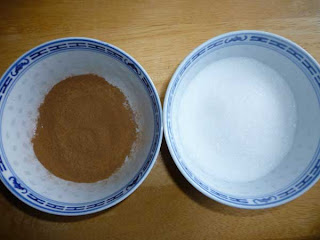Experiments with Real Whole Wheat
Not sure what this experiment was all about, now that it is over. Perhaps it started off experimenting with some household tools, but it ended off with an experiment in taste.
Recently I purchased a couple of old hand-crank coffee grinders for $30, thinking that they might be used to grind up some grains of various kinds. I hadn't used them for several weeks, they were just sitting in our den taking up space. But when I awoke today, I decided to just go ahead and see if they would grind up some whole grain wheat berries that I had on hand.
Indeed they did. And they grind it pretty quickly -- the only trouble being the tiny box is sometimes difficult to hold onto as you turn the handle. But it is able to grind maybe half a cup or so of grains fairly rapidly.
Then I became curious about the various sieves that we have in our kitchen. What if I ran this freshly milled flour through a sieve, to see what proportion of flour to bran is achieved by "bolting" it with my on-hand household implements?
[Why would I want to know this? Well, I have several recipes for miches, most notably Reinhart's version of Poilane's Miche (from the Bread Baker's Apprentice) that calls for a whole wheat flour that is sifted to a 90-95 percent extraction of bran. I have never made this bread because I didn't know if I could do it with what I have on hand. Would I require a special sieve, I wanted to know.]
I performed this experiment a couple of times, and discovered that you could pretty much stop whenever you wanted -- the larger pieces of bran will be left in the sieve, but you can keep shaking and make more of them, probably ultimately all of them, if you shake it long enough, will go through. So, for example, the first time I did it I got 4 g of bran and germ; the second time I did it, I stopped at 6 g of bran and germ.
The other day I read somewhere (was it the Laurel's Kitchen Bread Book?) that there are over 200% of the natural yeasts on the whole grains, as opposed to a store-bought flour, so if one is making a sourdough, it would be beneficial to start with the whole grain and grind your own flour to get these starters going. It occurred to me that my own sourdough starters might benefit from a boost like this, and the next time I refreshed them, I would indeed use only freshly milled flour to see what might happen.
I then decided I would perform yet another experiment, and I mixed up an equal amount of water by weight to the bolted flour, to see if some gluten would develop. I had 75g each of water and flour, and mixed it thoroughly. A bit of gluten did develop as I kneaded it for a short time in the bowl, but really 100% hydration is a bit too wet to develop a dough. What I had instead was more like porridge.
Then I added the bran and germ that I had removed, back into the mixture. Now I had 81g of flour to 75g of water (rounded off, this is about 93% hydration). The bran soaked up a lot of the water, and although the gluten would not further develop, I was able to make a loose dough. The scent of the newly milled grain soaking in water was interesting: one associates this with the scent of wet bran. And when I nibbled a bit of it, it reminded me of oatmeal. I had in fact, made a paste of wheat meal.
I then decided that I would fry it in some butter like a pancake or flapjack, and eat it. No salt (except what was in the butter) was added. I'd hesitate to call it a bread. It is not even a flatbread, in my opinion. It is really little more than a fried porridge or fried meal. But it occurred to me that many cultures world-wide have started with something this simple, and evolved it into something which they have named and made unique.
I just heated it on one side, flipped it, and heated it on the other.
The taste was still a little like oatmeal, perhaps a bit nuttier. There is a cleanness to the taste, that I can't describe: I assume that this is the germ hitting the tastebuds with no oxidation or rancidity, something one rarely experiences anymore when one doesn't grind one's own flour.
Pretty bland stuff, though. I put some homemade jam on it and ate it as a mid-day meal or snack.
Notes to Myself:
- Weigh some grain before grinding it and then seive off 5% of that weight -- it will be bran and germ that remains in the sieve. Use this to make a Poilane-style miche.
- Grind your own grain into flour to refresh your sourdough -- that is what Poilane did, and he should know.






















































